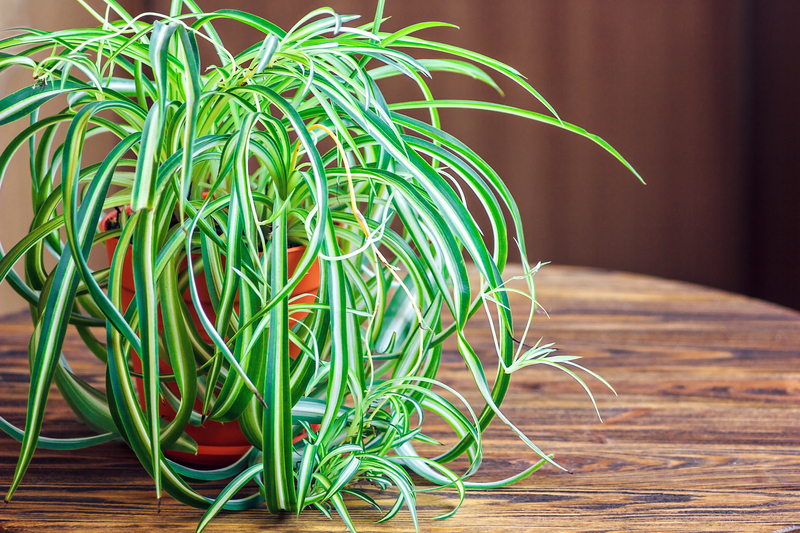Vertical Gardening for Beginners
Posted on 19/09/2025
Vertical Gardening for Beginners: A Comprehensive Guide
Are you short on space but dreaming of fresh herbs, tasty vegetables, or vibrant flowers? Vertical gardening for beginners is the perfect solution! This guide will help you discover how to transform small spaces into thriving, vertical green oases. Whether you have a tiny balcony, a bare wall, or an underutilized corner in your home, vertical gardening ideas for beginners can help you create a lush, productive garden.

What is Vertical Gardening?
Vertical gardening is a method of growing plants upward rather than outward. By using walls, trellises, shelves, or hanging containers, you can maximize growing space and add visual interest to your environment. Vertical gardening has become increasingly popular in urban settings, where outdoor space is often at a premium. But it's equally valuable for anyone who wants to make the most of their available area.
Why Choose Vertical Gardening?
- Saves Space: Ideal for balconies, patios, small yards, or even indoors.
- Boosts Yield: Grow more plants in less area compared to traditional gardens.
- Improves Air Quality: Plants help filter the air, making your living space healthier.
- Reduces Pests and Diseases: Elevating plants can reduce ground-borne pests and fungal diseases.
- Easy Maintenance: Vertical planters are typically easier to weed and water.
How Vertical Gardening Works
At its core, vertical gardening for small spaces involves supporting plants so they grow up, rather than out across the ground. This can be as simple as a hanging basket or as elaborate as a living wall. The principle remains the same: use vertical structures and creative techniques to let plants thrive in tight quarters.
Main Structures for Vertical Gardens
- Trellises: Wooden or metal frameworks for climbing plants like peas, beans, or ivy.
- Wall Planters: Modular systems or pockets attached to walls for herbs, flowers, or succulents.
- Pallet Gardens: Repurposed palettes with compartments for leafy greens or herbs.
- Hanging Pots: Suspend containers from ceilings, railings, or shelving units.
- Stacked Planters: Tiered structures that hold multiple pots in a pyramid or cascade.
Benefits of Vertical Gardening for Beginners
Embarking on a vertical garden project brings many rewards. Here's why starting a vertical garden as a beginner is a smart choice:
- Accessibility: Little bending or stooping, ideal for seniors or those with mobility issues.
- Aesthetic Appeal: Turn bland fences or walls into living works of art.
- Improved Microclimate: Vertical gardens can insulate buildings, reduce heat, and improve humidity indoors.
- Enhances Privacy: Growing tall plants or thick green walls offers more privacy in tight urban spaces.
- Encourages Creativity: Try new combinations, designs, and crops all in one limited space.
Choosing the Best Plants for Vertical Gardening
Not all plants are suitable for vertical gardens. When choosing what to grow, consider plants that are naturally compact or climb well with minimal guidance. Below are the top choices for vertical gardening for beginners:
Vegetables and Herbs
- Lettuce, spinach, and leafy greens: Shallow roots, quick to harvest, and thrive in vertical systems.
- Herbs: Basil, thyme, oregano, parsley, mint, chives--all perfect for wall planters and hanging baskets.
- Tomatoes: Especially cherry and compact varieties--grow up with support.
- Peppers: Small peppers do well in containers and vertical pockets.
- Beans and peas: Naturally climbing plants that flourish on trellises.
Flowers and Ornamentals
- Petunias, pansies, nasturtiums: Trailing flowers add color and attract pollinators.
- Succulents: Hardy, low-maintenance, perfect for living walls.
- Ivy, morning glories, sweet peas: Quick climbers ideal for dramatic green curtains.
Tip: When planning vertical gardens for beginners, start small--choose a few easy-to-grow varieties before expanding.
Getting Started: Step-by-Step Guide
Step 1: Assess Your Space and Light
- Look at walls, fences, balconies, or even indoor surfaces like kitchen walls.
- Note hours of sunlight--most edibles require 6+ hours of direct sun daily.
- If light is low, focus on shade-tolerant plants like ferns or some herbs.
Step 2: Choose Your Vertical Structure
- Wall Planters: Great for herbs, succulents, or flowers; available in fabric pockets, ceramic, or plastic.
- Pallet Gardens: Repurpose wood pallets for a rustic, budget-friendly look.
- Trellises and Arbors: Best for climbing vegetables like beans and cucumbers.
- Stacked or Tiered Containers: Perfect for strawberries, herbs, or lettuces.
Step 3: Select the Right Soil and Fertilizer
- Use high-quality potting mix, not garden soil, for better drainage and nutrients.
- Add slow-release organic fertilizer to support steady plant growth.
Step 4: Plant Your Garden
- Arrange plants with similar light and water needs together.
- Place trailing or vining plants near the top so they cascade downward.
- Compact, leafy plants fit well in vertical pockets in the middle or lower levels.
Step 5: Watering and Maintenance
- Vertical gardens dry out faster than traditional beds--check soil moisture daily.
- Install drip irrigation or self-watering systems for convenience.
- Feed plants as needed; prune regularly to encourage growth and prevent overcrowding.
Step 6: Harvest and Enjoy!
- Pick herbs and greens often to encourage new growth.
- Enjoy your bountiful harvest--nothing matches the taste and satisfaction of homegrown produce!
Common Vertical Garden Problems & Solutions
1. Overcrowding
Solution: Space plants as recommended on seed packets; trim or replant overcrowded sections.
2. Watering Issues
Solution: Use moisture-retaining soil, group thirsty plants together, and add drip irrigation if possible.
3. Poor Light
Solution: Relocate your garden or supplement with grow lights indoors; choose shade-loving plants for low-light spots.
4. Nutrient Deficiency
Solution: Feed regularly with diluted liquid fertilizer or compost tea to replenish nutrients lost through watering.
Creative Vertical Gardening Ideas for Beginners
- Mason jar herb gardens: Attach jars to a wooden plank for a rustic, indoor herb display.
- Shoe organizer planters: Hang a fabric shoe tidy on a fence, fill with soil, and plant compact veggies or flowers.
- Gutter gardens: Fix old rain gutters to a fence or wall and grow trailing strawberries or greens.
- Hanging bottle planters: Upcycle plastic bottles into vertical herb gardens by hanging them in rows.
- Ladder plant stands: Repurpose an old ladder to house a variety of pots on each step.
Get creative and experiment! There's no single right way to build a vertical gardening system for beginners--find what works for you and your space.
Vertical Gardening Tips for Success
- Start small, think big: Begin with one structure and expand as your skills and enthusiasm grow.
- Mix and match: Combine vegetables, herbs, and flowers for a colorful, productive display.
- Rotate crops: Replant with different varieties each season to keep soil healthy.
- Monitor pests: Check regularly for aphids or spider mites; treat early using organic methods.
- Keep records: Jot down what you plant and how it performs to improve your setup each year.

Frequently Asked Questions about Vertical Gardening for Beginners
Can I set up a vertical garden indoors?
Absolutely! Use wall-mounted shelves, indoor trellises, or hanging planters near sunny windows. Indoor vertical gardens for beginners are great for herbs or low-light houseplants like pothos and philodendrons.
How often should I water my vertical garden?
Depending on exposure and plant type, vertical gardens may need daily light watering, especially in hot or dry climates. Check soil moisture often and adjust as needed.
What is the easiest vertical garden for a beginner?
A hanging pocket planter for herbs or a small trellis for peas and beans are simple, low-maintenance options to begin your vertical gardening journey.
Is vertical gardening expensive?
Vertical gardens can be as budget-friendly or elaborate as you like. Upcycle materials such as old pallets, shoe organizers, or bottles to save money.
Final Thoughts: Grow Up and Garden Smart!
Vertical gardening for beginners is an exciting, versatile way to enjoy the rewards of gardening--no matter your space or skill level. With a little creativity and planning, you can grow fresh food, gorgeous flowers, or lush greenery almost anywhere.
- Start with easy vertical garden projects.
- Choose the right plants for your conditions.
- Maintain a consistent watering and feeding schedule.
- Experiment and have fun as you learn what works for your unique situation!
Ready to get growing? Embrace the world of vertical gardening and transform your small space into a thriving green retreat. Happy planting!



